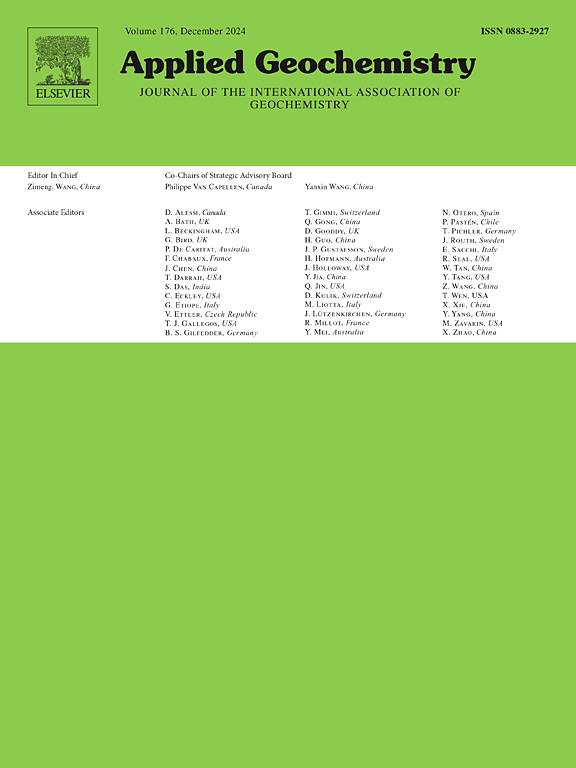Groundwater arsenic and the role of secondary Fe/Mn hydroxides in a volcaniclastic aquifer, Guanacaste, Costa Rica
IF 3.1
3区 地球科学
Q1 GEOCHEMISTRY & GEOPHYSICS
引用次数: 0
Abstract
Elevated arsenic (As) in the regional water supply from a volcaniclastic aquifer in Costa Rica is an example of the increasing problem of As-contaminated waters in aquifers throughout Latin America. In this study, potential sources of As were assessed by (1) measuring the solid-phase chemical composition of volcaniclastic aquifer sediments and intercalated paleosols, (2) analyzing As speciation and availability by sub-millimeter scale elemental mapping and targeted chemical extractions, and (3) mapping spatial trends of As in shallow drinking water wells, surficial hot springs, and deep wells producing geothermal waters. Iron-manganese hydroxides (Fe/Mn hydroxides) in this aquifer system contain 210–530 ppm As that sorbs to this solid phase when released by chemical weathering of As-bearing volcanic glass. Arsenic is primarily transferred from solid to aqueous state when groundwater conditions shift from oxidizing to reducing, likely driven by presence of organic matter or periods of water logging (e.g. rainy season or irrigation). The occurrence of isolated hot springs raises the possibility that arsenic in groundwater may result from mixing of low-As meteoric waters with localized high-As thermal waters (hot springs). However, experimental evidence for release of As upon reductive dissolution of Fe/Mn hydroxides in solid-phase aquifer sediments plus the homogeneous and widespread 10–60 ppb As content in drinking water wells indicate that Fe/Mn hydroxide breakdown is the primary cause of the widespread As contamination in the regional aquifer. Locally, natural upwelling of thermal waters may affect wells in close proximity to surficial hot springs, but minimal evidence of this was observed in this study. Given the high incidence of elevated As in groundwater in volcaniclastic aquifers in Latin America and similar environments globally, these results are applicable to understanding As speciation and source, in particular drawing attention to the significance of secondary Fe/Mn hydroxides in arsenic cycling in volcaniclastic aquifers.

哥斯达黎加瓜纳卡斯特火山碎屑含水层中地下水砷和次生铁/锰氢氧化物的作用
哥斯达黎加火山碎屑含水层的区域供水中砷含量升高是整个拉丁美洲含水层中砷污染水问题日益严重的一个例子。通过测量火山碎屑含水层沉积物和夹层古土壤的固相化学成分,利用亚毫米尺度元素填图和定向化学提取分析As的形态和可利用性,绘制浅水井、地表温泉和地热水深井中As的空间变化趋势,对As的潜在来源进行了评估。该含水层系统中的铁锰氢氧化物(Fe/Mn氢氧化物)含有210-530 ppm的砷,当含砷火山玻璃的化学风化作用释放时,砷被吸附到固体相中。当地下水从氧化状态转变为还原状态时,砷主要从固体状态转移到水状态,这可能是由有机物的存在或涝期(例如雨季或灌溉期)驱动的。孤立温泉的出现提出了地下水中砷可能是低砷大气水与局部高砷温泉水(温泉)混合的结果。然而,固相含水层沉积物中Fe/Mn氢氧化物还原溶解释放As的实验证据以及饮用水中10-60 ppb的均匀和广泛的As含量表明,Fe/Mn氢氧化物分解是区域含水层广泛存在As污染的主要原因。局部地区,热水的自然上涌可能会影响靠近地表温泉的水井,但本研究中观察到的证据很少。鉴于拉丁美洲和全球类似环境中火山碎屑含水层地下水中砷含量升高的高发生率,这些结果适用于了解砷的形态和来源,特别是提请注意次生铁/锰氢氧化物在火山碎屑含水层中砷循环中的重要性。
本文章由计算机程序翻译,如有差异,请以英文原文为准。
求助全文
约1分钟内获得全文
求助全文
来源期刊

Applied Geochemistry
地学-地球化学与地球物理
CiteScore
6.10
自引率
8.80%
发文量
272
审稿时长
65 days
期刊介绍:
Applied Geochemistry is an international journal devoted to publication of original research papers, rapid research communications and selected review papers in geochemistry and urban geochemistry which have some practical application to an aspect of human endeavour, such as the preservation of the environment, health, waste disposal and the search for resources. Papers on applications of inorganic, organic and isotope geochemistry and geochemical processes are therefore welcome provided they meet the main criterion. Spatial and temporal monitoring case studies are only of interest to our international readership if they present new ideas of broad application.
Topics covered include: (1) Environmental geochemistry (including natural and anthropogenic aspects, and protection and remediation strategies); (2) Hydrogeochemistry (surface and groundwater); (3) Medical (urban) geochemistry; (4) The search for energy resources (in particular unconventional oil and gas or emerging metal resources); (5) Energy exploitation (in particular geothermal energy and CCS); (6) Upgrading of energy and mineral resources where there is a direct geochemical application; and (7) Waste disposal, including nuclear waste disposal.
 求助内容:
求助内容: 应助结果提醒方式:
应助结果提醒方式:


